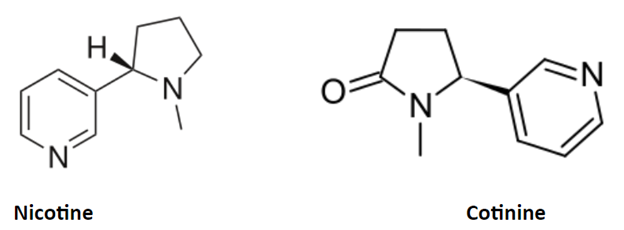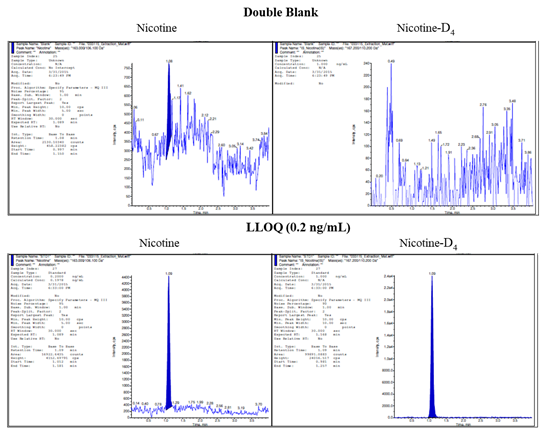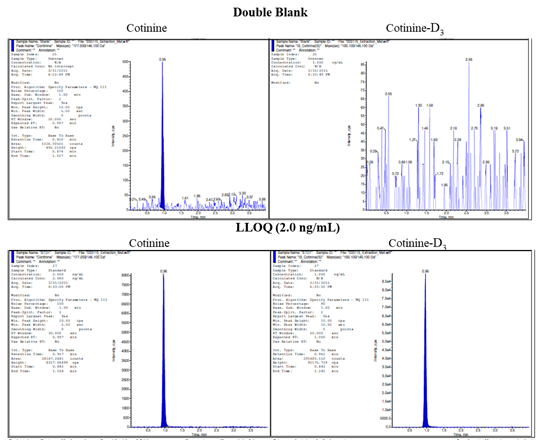Clinical Research Spotlight: Nicotine Method

A Bioanalytical Method for the Analysis of Nicotine in Human Plasma
With its boutique bioanalytical laboratory, contract research organization BioPharma Services, Inc. specializes in small molecule bioanalysis with more than 200 biological assays for various therapeutic products. Dr. Nicola Hughes, the vice president of BioPharma’s bioanalytical laboratory operations, oversees the lab team of 25 staff members.
As part of the study, Dr. Hughes and her team developed a bioanalytical testing method for the analysis of Nicotine and its metabolite Cotinine in human plasma. The method described herein has been successfully applied in the pharmacokinetics assessment of therapeutic doses of Nicotine in human clinical trials.
Nicotine As ETS and As Replacement Therapy
Cigarette smoking is the most common form of tobacco use worldwide, with more than 6 trillion cigarettes smoked annually. Environmental tobacco smoke (ETS) refers to being exposed to someone else’s smoke, and it is estimated that from ETS alone, there is 22 million kg of Nicotine released into the atmosphere each year. Nicotine is present in the air, on surfaces and in dust and is a ubiquitous environmental contaminant.
In addition to being present in tobacco smoke, Nicotine is also indicated for smoking cessation to relieve withdrawal symptoms. Nicotine replacement therapy provides Nicotine in the form of gum, patches, sprays, and inhalers without the other harmful chemicals present in tobacco.
In humans, more than 70% of Nicotine is metabolized into Cotinine. While Cotinine itself is not an environmental contaminant, it is a marker of exposure to ETS (e.g., it will be present in the plasma of non-smokers exposed to significant levels of Nicotine).

Bioanalytical Considerations
- A significant challenge in developing a bioanalytical method for Nicotine and Cotinine is finding suitable sources of plasma that are free of a significant level of both substances. The use of activated charcoal to remove these environmental contaminants has been reported. This has the disadvantage of producing an essentially “surrogate matrix” and adds considerable time and content to the method validation that is required to be conducted in both surrogate and authentic matrix.
- ETS contamination of workbenches, equipment and labware.
- Nicotine and Cotinine are basic alkaloids containing pyrrolidine and pyridine rings. Under classic LC-MS-friendly low-pH mobile phases with reverse-phase chromatographic conditions, these molecules are protonated and poorly retained with tailing peak shapes. High pH buffers give better peak shapes and more reproducible retention, but sensitivity is compromised. Success with a more MS-friendly mobile phase under HILIC conditions has also been reported.
Our Strategy
- Extensive plasma screening was performed to select sources from un-exposed non-tobacco users, as evidenced by levels of Nicotine and Cotinine of less than 20% of their respective LLOQs (see representative chromatograms).
- Extensive cleaning of lab benches, equipment and labware was conducted to minimize the impact from ETS. Non-smokers performed all laboratory activities, and they used disposable lab coats.
- Various HPLC columns and conditions were tested, and the use of a HILIC column was found to be suitable.
Representative Chromatograms


Summary
As stated in the introduction, BioPharma’s Bioanalytical Laboratory successfully developed a bioanalytical method for the analysis of Nicotine and its metabolite Cotinine in human plasma.
Briefly, the linear dynamic range of the method is from 0.20 ng/mL to 15.00 ng/mL for Nicotine and 2.00 ng/mL to 150.00 ng/mL for Cotinine. The assay utilizes a solid-phase extraction requiring 200 µL of human plasma with stable label internal standards (Nicotine-D4 and Cotinine-D3). Samples are chromatographically separated using a HILIC analytical column and a gradient mobile phase containing acetonitrile and methanol in ammonium acetate. The AB Sciex API 4000 mass spectrometric instrument is operated in positive ion mode using a Turbo IonSpray source and MRM detection. The total run time for a 10 µL injection is 4.0 minutes per sample.
Under the optimized extraction, chromatographic and detection conditions, a selective, sensitive, accurate and precise method was validated with no significant impact from contamination from ETS.
The method has been successfully applied in the pharmacokinetics assessment of therapeutic doses of Nicotine in human clinical trials.
About the Author
Dr. Nicola Hughes joined the BioPharma Services team in 2016, bringing with her more than 20 years of research experience and proven leadership skills. As vice president of Bioanalytical Laboratory Operations, her mandate starts with R&D, to develop robust and reliable methods to drive efficiency, expedite analysis and deliver accurate and time-critical results. Under her leadership, BioPharma delivers best-in-class bioanalytical services, making it a global leader in clinical research. In addition to being an accomplished leader and scientist, Dr. Hughes is a businesswoman and vineyard co-founder. Learn more about her unique journey here.
About BioPharma Services
BioPharma Services, Inc., a Think Research Corporation company, is a full-service Contract Research Organization (CRO) based in Toronto, Canada, specializing in Phase I/IIa and Bioequivalence clinical trials for international pharmaceutical companies worldwide. BioPharma has clinical facilities both in the USA and Canada with access to healthy volunteers and special populations.



